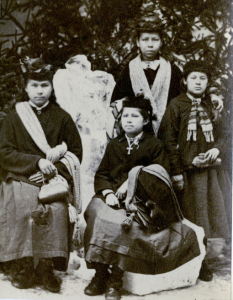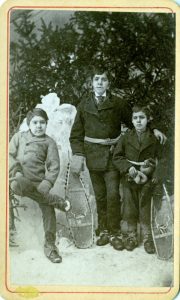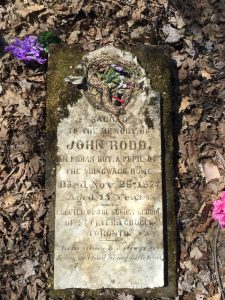4 Student Death Part 2
Frederick Oshkapukeda was not the only student who died during the early years of the Shingwauk Residential School. Between the opening of the School in 1874 and 1882, at least eight other students died while in residence at Shingwauk, and two other former students died at home. They died from a variety of illnesses including tuberculosis, meningitis, and typhoid fever. These illness resulted from a combination of poor living conditions, an immune system weakened by emotional trauma and malnutrition, and poor working and sanitary conditions at the school (Truth and Reconciliation Commission, 2015). A large number of students contracted these and other illnesses, and while many survived the following are the stories of the students who did not make it through. The majority of the students who died at Shingwauk were buried in the Shingwauk Cemetery, but out of all the students mentioned below and in following chapters, only the markers for John Rodd’s and William Sahgucheway’s graves remain. This chapter will discuss the first three deaths at the School.
The first student who died at Shingwauk was Hannah Weezhoo. Called Naswahbequa “Looking Three Ways” by her family, she entered the school in 1874 when the new stone building opened on Queen Street after the original schoolhouse in Garden River burnt down. Hannah was from Walpole Island, and her family had already been Christianized and were part of the Church of England (i.e. the Anglican Church). She was learning the laundry trade but died suddenly on Jan 30, 1876 of an undescribed brain disease. Buried three days later, she was the first student buried in the Shingwauk cemetery, which was not consecrated until later that summer. Hannah’s grave was marked with a wooden slab painted white which included her name, date of death, and a bible verse. This marker does not survive and the exact location of Hannah’s grave is unknown.

Solomon Corning died only a few months after Hannah, on May 18, 1876. Shebahjewun “Flowing Through a Gap” came to Shingwauk from the Sarnia Reserve in September of 1875 when he was only seven years old. Principal Rev. E. F. Wilson noted in his register that Solomon was scrofulous when he came to the school. Scrofula is a type of tuberculosis that occurs outside the lungs, also known as the King’s Evil (Healthline, n.d.). According to the Rev. E. F. Wilson, Solomon did not make much progress while at the School, and died from a scrofulous abscess in his neck after only attending the school for eight months. Like Hannah, he was buried in the Shingwauk cemetery before it could be consecrated. Solomon’s grave marker would have been similar to Hannah’s, and it too does not survive.
John Rodd, also known as Nahwegahbowh “Stand in the Middle” is the first death recorded in Rev. E. F. Wilson’s letter books in the University Archives (the letter books begin in late 1876, after Hannah and Solomon’s deaths). John Rodd had been at the School since it originally opened in Garden River in 1873. He was eleven years old at the time, from Sarnia, and was one of Wilson’s first students. John ran away with his brother Pilate and student William Grey sometime in late 1875 or early 1876, but all three were brought back within a few weeks. John became a printing apprentice and helped to print the Algoma Missionary News and Shingwauk Journal.

He became ill in early November 1877 with a “bilious attack” which usually means headache, abdominal pain, vomiting, etc. The doctor was not sent for until John’s symptoms became more serious five days before his death. He died from cerebro spinal meningitis on November 28, 1877 at around 10 in the morning. A funeral was held for him a few days later and he was buried in the Shingwauk cemetery. Rev. Wilson wrote to John’s mother to explain the circumstances of his death, and in the Spring she wrote back asking for John’s body to be exhumed and sent to Sarnia. Wilson objected to this, saying it would be very unpleasant since it had been so long already, and it was better to leave him where he was. However, Rev. Wilson offered Mrs Rodd a room at Shingwauk for the summer so she could come and visit John’s grave and stay with her other son Pilate. It doesn’t seem as though she took him up on this offer, since there are no further letters confirming details. Through his printing apprenticeship, John had $7 in his Savings Account, which went to Pilate after John’s death. A more detailed account of John’s time at the school, his death, and his funeral was published in the February 1878 issue of Algoma Missionary News which can be read here.


